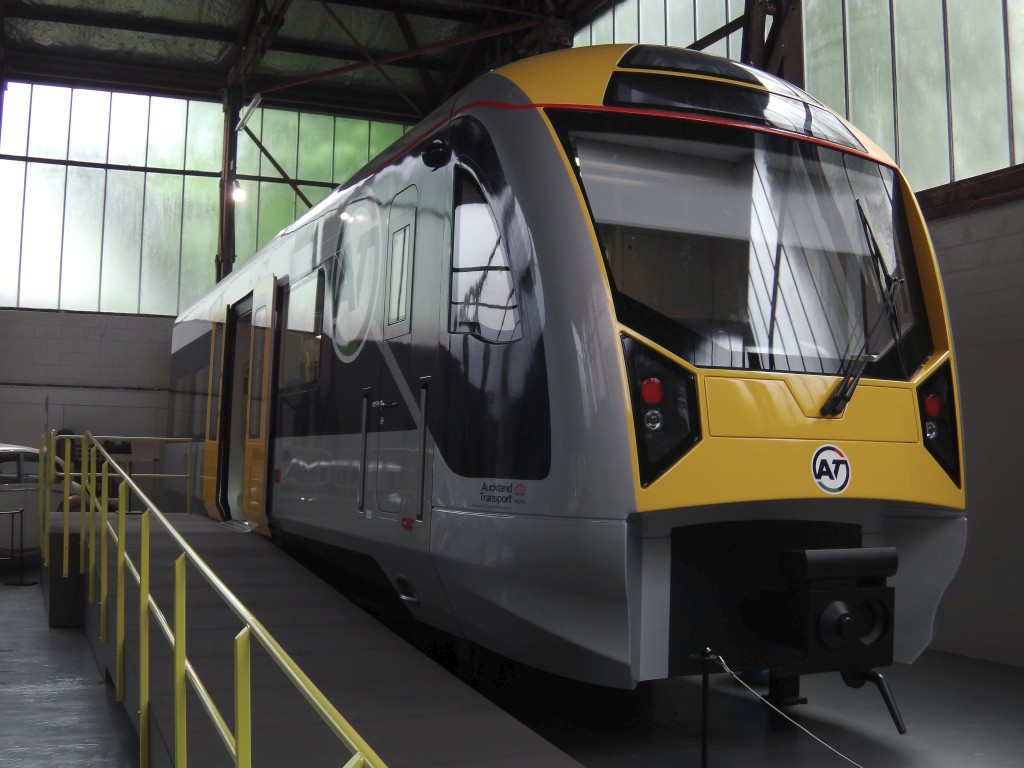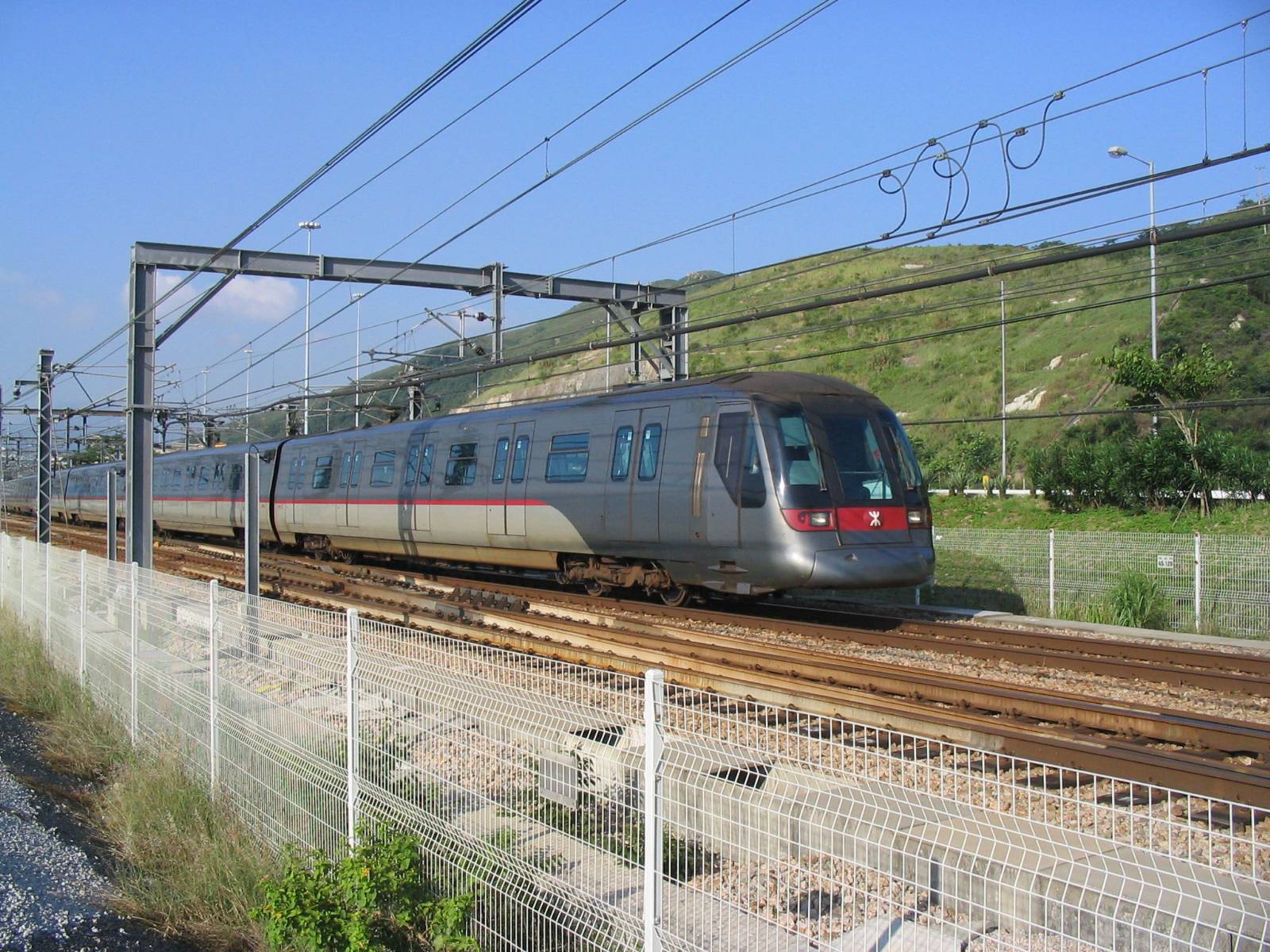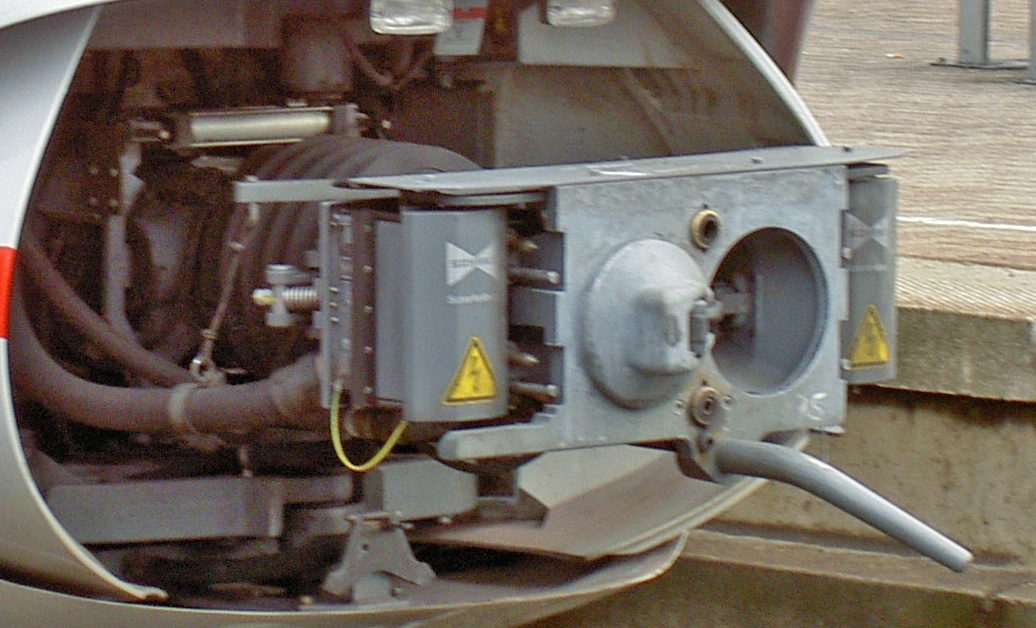|
New Zealand AM Class Electric Multiple Unit
The New Zealand AM class of electric multiple unit (EMU) was constructed for the electrification of Auckland's railway network. The class was introduced in 2014 with the first unit having arrived in September 2013. The units are classified AM (Auckland Metro), with the driving motor car with pantograph classified AMP, the middle trailer car AMT and the driving motor car without pantograph AMA. The trains are operated by Transdev Auckland for Auckland Transport under the AT Metro brand. History In February 2010, an "industry engagement document" preceding the formal call for tenders was published, calling for 114 EMU cars in 38 three-car sets, capable of being coupled as six-car trains, the maximum Auckland's stations can handle. The tender also included 13 electric locomotives (which did not eventuate). The sets would have seated around 240 passengers. While the document specified only a small number of elements, it required a speed of 110 km/h for fully laden trains, a min ... [...More Info...] [...Related Items...] OR: [Wikipedia] [Google] [Baidu] |
Construcciones Y Auxiliar De Ferrocarriles
Construcciones y Auxiliar de Ferrocarriles (Grupo CAF, literally "Construction and Other Railway Services") is a Spanish publicly listed company which manufactures railway vehicles and equipment and buses through its Solaris Bus & Coach subsidiary. It is based in Beasain, Basque Autonomous Community, Spain. Equipment manufactured by Grupo CAF includes light rail vehicles, rapid transit trains, railroad cars and locomotives, as well as variable gauge axles that can be fitted on any existing truck or bogie. Over the 20 years from the early 1990s, CAF benefited from the rail investment boom in its home market in Spain to become a world player with a broad technical capability, able to manufacture almost any type of rail vehicle. CAF has supplied railway rolling stock to a number of major urban transit operators around Europe, the US, South America, East Asia, India, Australia and North Africa. History ''CAF'' was an acronym for the earlier name of ''Compañía Auxiliar de Fer ... [...More Info...] [...Related Items...] OR: [Wikipedia] [Google] [Baidu] |
Eastern Line (Auckland)
The Eastern Line is the name of the suburban rail service in Auckland, New Zealand between Britomart and Manukau via the North Island Main Trunk (NIMT) and Manukau Branch. Services are operated by Auckland One Rail under the Auckland Transport brand. In December 2014, all Eastern Line train services began terminating at Manukau, rather than alternating between Manukau and Papakura. Electrification of the Auckland suburban network was completed in July 2015, and all passenger services on this line are electrified. Construction The line from Auckland to Westfield via Glen Innes was constructed as the Westfield Deviation of the North Island Main Trunk. This eastern deviation had been proposed as early as the 1870s, but various events meant that it was never constructed, until traffic on the Auckland – Newmarket section of the NIMT began to experience significant delays. The Westfield Deviation avoided the major grades of the route via Newmarket and Remuera, which had a high ... [...More Info...] [...Related Items...] OR: [Wikipedia] [Google] [Baidu] |
AT Metro
AT Metro is the public transport brand in Auckland, New Zealand, managed by Auckland Transport. It was launched in December 2014, following the decommissioning of the MAXX brand with updated bus and train liveries, staff uniforms, wayfinding signage and a refreshed external communications identity. Usage Bus operator contracts were updated in late-2014 requiring fleets to be repainted in AT Metro livery in tandem with their standard maintenance schedule. Staff uniforms are also to be rolled out within a similar timeframe. Auckland Transport's new electric train fleet was manufactured with the new livery. Liveries differ depending on the service, with rapid transit services ( Northern Express bus and rail) in AT Blue and AT Silver accented in yellow highlights; specialty bus services ( Link and Airporter) in custom, distinguishable colours; and other bus services in AT Blue and AT Silver. History AT Metro replaced the MAXX brand, introduced by the former Auckland Regional Tra ... [...More Info...] [...Related Items...] OR: [Wikipedia] [Google] [Baidu] |
The New Zealand Herald
''The New Zealand Herald'' is a daily newspaper published in Auckland, New Zealand, owned by New Zealand Media and Entertainment, and considered a newspaper of record for New Zealand. It has the largest newspaper circulation of all newspapers in New Zealand, peaking at over 200,000 copies in 2006, although circulation of the daily ''Herald'' had declined to 100,073 copies on average by September 2019. Its main circulation area is the Auckland region. It is also delivered to much of the upper North Island including Northland, Waikato and King Country. History ''The New Zealand Herald'' was founded by William Chisholm Wilson, and first published on 13 November 1863. Wilson had been a partner with John Williamson in the ''New Zealander'', but left to start a rival daily newspaper as he saw a business opportunity with Auckland's rapidly growing population. He had also split with Williamson because Wilson supported the war against the Māori (which the ''Herald'' termed "the ... [...More Info...] [...Related Items...] OR: [Wikipedia] [Google] [Baidu] |
Auckland
Auckland (pronounced ) ( mi, Tāmaki Makaurau) is a large metropolitan city in the North Island of New Zealand. The most populous urban area in the country and the fifth largest city in Oceania, Auckland has an urban population of about It is located in the greater Auckland Region—the area governed by Auckland Council—which includes outlying rural areas and the islands of the Hauraki Gulf, and which has a total population of . While Europeans continue to make up the plurality of Auckland's population, the city became multicultural and cosmopolitan in the late-20th century, with Asians accounting for 31% of the city's population in 2018. Auckland has the fourth largest foreign-born population in the world, with 39% of its residents born overseas. With its large population of Pasifika New Zealanders, the city is also home to the biggest ethnic Polynesian population in the world. The Māori-language name for Auckland is ', meaning "Tāmaki desired by many", in ref ... [...More Info...] [...Related Items...] OR: [Wikipedia] [Google] [Baidu] |
Auckland Railway Electrification
Auckland railway electrification occurred in phases as part of investment in a new infrastructure for Auckland's urban railway network. Electrification of the network had been proposed for several decades. Installation started in the late 2000s after funds were approved from a combination of regional ( Auckland Regional Council, later Auckland Council) and central government ( NZ Transport Agency) budgets. In the 2007 budget the Fifth Labour government announced that Auckland suburban railway lines from Swanson in the west to Papakura in the south and including the Manukau and Onehunga branch lines would be electrified at . Diesel DMU services would remain for Waitakere and perhaps Huapai and Pukekohe. A 2013 announcement said that because of cost, bus services would remain between Waitakere and Swanson, and did not mention an extension to Huapai. The $80 million contract for the electrification infrastructure was awarded on 14 January 2010 to an Australian and New Zealand conso ... [...More Info...] [...Related Items...] OR: [Wikipedia] [Google] [Baidu] |
Electric Multiple Unit
An electric multiple unit or EMU is a multiple-unit train consisting of self-propelled carriages using electricity as the motive power. An EMU requires no separate locomotive, as electric traction motors are incorporated within one or a number of the carriages. An EMU is usually formed of two or more semi-permanently coupled carriages, but electrically powered single-unit railcars are also generally classed as EMUs. The great majority of EMUs are passenger trains, but versions also exist for carrying mail. EMUs are popular on commuter and suburban rail networks around the world due to their fast acceleration and pollution-free operation. Being quieter than diesel multiple units (DMUs) and locomotive-hauled trains, EMUs can operate later at night and more frequently without disturbing nearby residents. In addition, tunnel design for EMU trains is simpler as no provision is needed for exhausting fumes, although retrofitting existing limited-clearance tunnels to accommodate th ... [...More Info...] [...Related Items...] OR: [Wikipedia] [Google] [Baidu] |
Scharfenberg Coupler
The Scharfenberg coupler (german: Scharfenbergkupplung, abbreviated ''Schaku'') is a commonly used type of fully automatic railway coupling. Designed in 1903 by Karl Scharfenberg in Königsberg, Germany (today Kaliningrad, Russia), the coupler has gradually spread from transit trains to regular passenger service trains, although outside Europe its use is generally restricted to mass transit systems. The ''Schaku'' is superior in many ways to the AAR (Janney/knuckle) coupler because it also automates electrical and pneumatic connections and disconnections. However, there is no standard for the placement of these electro-pneumatic connections. Some rail operators have placed them on the sides while others have placed them either below or above the mechanical portion of the coupler. . Working principles The face of the Scharfenberg coupler has a protruding cone and a matching cup. Inside the cone there is a rigid metal hoop connected to a revolving, spring-loaded metal disk with a ... [...More Info...] [...Related Items...] OR: [Wikipedia] [Google] [Baidu] |
European Train Control System
The European Train Control System (ETCS) is the signalling and control component of the European Rail Traffic Management System (ERTMS). It is a replacement for legacy train protection systems and designed to replace the many incompatible safety systems currently used by European railways. The standard was also adopted outside Europe and is an option for worldwide application. In technical terms it is a type of positive train control (PTC). ETCS is implemented with standard trackside equipment and unified controlling equipment within the train cab. In its advanced form, all lineside information is passed to the driver wirelessly inside the cab, removing the need for lineside signals watched by the driver. This will give the foundation for a later to be defined automatic train operation. Trackside equipment aims to exchange information with the vehicle for safely supervising train circulation. The information exchanged between track and trains can be either continuous or ... [...More Info...] [...Related Items...] OR: [Wikipedia] [Google] [Baidu] |
Pantograph (transport)
A pantograph (or "pan" or "panto") is an apparatus mounted on the roof of an electric train, tram or electric bus to collect power through contact with an overhead line. By contrast, battery electric buses and trains are charged at charging stations. The pantograph is a common type of current collector; typically, a single or double wire is used, with the return current running through the rails. The term stems from the resemblance of some styles to the mechanical pantographs used for copying handwriting and drawings. Invention The pantograph, with a low-friction, replaceable graphite contact strip or "shoe" to minimise lateral stress on the contact wire, first appeared in the late 19th century. Early versions include the bow collector, invented in 1889 by Walter Reichel, chief engineer at Siemens & Halske in Germany, and a flat slide-pantograph first used in 1895 by the Baltimore and Ohio Railroad The familiar diamond-shaped roller pantograph was devised and patente ... [...More Info...] [...Related Items...] OR: [Wikipedia] [Google] [Baidu] |
Overhead Line
An overhead line or overhead wire is an electrical cable that is used to transmit electrical energy to electric locomotives, trolleybuses or trams. It is known variously as: * Overhead catenary * Overhead contact system (OCS) * Overhead equipment (OHE) * Overhead line equipment (OLE or OHLE) * Overhead lines (OHL) * Overhead wiring (OHW) * Traction wire * Trolley wire This article follows the International Union of Railways in using the generic term ''overhead line''. An overhead line consists of one or more wires (or rails, particularly in tunnels) situated over rail tracks, raised to a high electrical potential by connection to feeder stations at regular intervals. The feeder stations are usually fed from a high-voltage electrical grid. Overview Electric trains that collect their current from overhead lines use a device such as a pantograph, bow collector or trolley pole. It presses against the underside of the lowest overhead wire, the contact wire. Current colle ... [...More Info...] [...Related Items...] OR: [Wikipedia] [Google] [Baidu] |
Stainless Steel
Stainless steel is an alloy of iron that is resistant to rusting and corrosion. It contains at least 11% chromium and may contain elements such as carbon, other nonmetals and metals to obtain other desired properties. Stainless steel's resistance to corrosion results from the chromium, which forms a passive film that can protect the material and self-heal in the presence of oxygen. The alloy's properties, such as luster and resistance to corrosion, are useful in many applications. Stainless steel can be rolled into sheets, plates, bars, wire, and tubing. These can be used in cookware, cutlery, surgical instruments, major appliances, vehicles, construction material in large buildings, industrial equipment (e.g., in paper mills, chemical plants, water treatment), and storage tanks and tankers for chemicals and food products. The biological cleanability of stainless steel is superior to both aluminium and copper, having a biological cleanability comparable to glass. I ... [...More Info...] [...Related Items...] OR: [Wikipedia] [Google] [Baidu] |



_p225_AUCKLAND%2C_NEW_ZEALAND.jpg)





.jpg)
